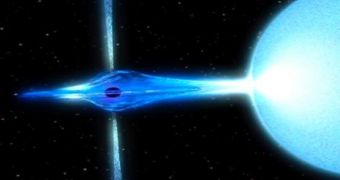The theory regarding the formation process of a black hole is closely related to that of the life of a star. The general belief is that these strange objects represent one of the possible final stages of a star that has a mass at least ten times greater than that of the Sun. However, the most massive black holes can only be found in so-called 'quasars' or Quasi Stellar Radio Sources which, during the interaction between the matter and the actual black hole, radiate light over extremely vast distances or even across the entire universe.
Usually, the massive stars that spawn black holes at their death are formed in regions of space that present a highly dense matter. As the stellar core of a giant star collapses on itself, it may form a black hole, after which it will start to 'feed' itself, with the help of its powerful gravitational field, accreting matter and forming an accretion disk that gravitates it and heats up, giving large amounts of radiation and light. If the black hole has enough material in its vicinity to feed on, it will eventually grow bigger and draw in even more matter and will create a quasar. The objects can usually be found in galactic nuclei of most of the large galaxies; however, they do not explain how supermassive black holes develop.
Though the formation process of small black holes, which have masses up to several hundred that of the Sun, is relatively well known and easy to explain, supermassive black holes could grow as big as a billion times as massive. Some theories involve the possibility of feeding on other stars or gas, or even of merging with other black holes during a collision. However, these theories do not explain the fact that they grow very quickly, taking into account the age of the universe. Some of the first supermassive black holes were formed only a few hundred million years after the Big Bang.
Most of the matter in the visible universe is still in the form of hydrogen and helium. Mitchell Begelman, from the University of Colorado, believes that massive clouds of hydrogen and helium could collapse extremely rapidly, to form giant stars, but the rapid accumulation of gas could trigger a sudden core collapse, directly into a small black hole. Normally, stars with masses just a few times greater than the Sun release the excess energy of the collapsing process, by ejecting the outer layers of hot gas, in an explosive process known as a supernova. However, stars with masses more than 1,000 time greater than that of the Sun could become so compact, that all the energy that is usually ejected would be absorbed thus containing the explosion to form a black-hole star.
It would grow extremely rapidly into a supermassive black hole, feeding on the remnant debris of the supernova, heating up the gas in order to release high amounts of light, and creating enough pressure to hold the upper layers of the star above it.
This situation presents an unstable outcome, as dense hot gas will create pressure on the lighter layer. According to Begelman, the black-hole star would stabilize itself, by releasing part of the pressure in the form of light that escapes from the lower lighter layers, and creating bursts of radiation, which are visible in quasars.
After this stage that can last as long as a million years, the black hole could reach an incredible 10,000 solar mass, traveling through space to swallow other stars or black holes. Calculations show that these types of quasi stellar objects would usually be cooler than our Sun, and might have as much as 10 billion kilometers in diameter, and radiate enough light to outshine a small galaxy.
Nevertheless, predictions regarding the existence of these objects show that they would most likely have existed in the early life of the universe, so the expansion of space shifted their light towards the infrared spectrum that is absorbed by the Earth's atmosphere, making its detection close to impossible.
So, the only option is to look for them from out of space. The sensitive instruments on board the James Webb Space Telescope that are scheduled to launch in 2013, operating in the infrared wavelength, might be able to spot the weak signature left behind by quasars.

 14 DAY TRIAL //
14 DAY TRIAL //